Final report for FNE17-868
Project Information
The purpose of our on-farm experiment was to determine the effectiveness of several weed, plant, and downy mildew management practices on the infection rate by downy mildew (DM) and yield in hops (Humulus lupulus). In order to assess whether effective weed control significantly reduces DM presence and economic loss, we compared the relative rate of DM infection at four key points in growing season, from spring through post-harvest in two hop varieties (Mount Hood: moderately susceptible to DM infection, and Cascade: moderately resistant) using four experimental treatments: 1) sheep-weeded hopyard with no fungicide applied, 2) fungicide only - Champ, a copper-based fungicide and Regalia, a biofungicide , 3) organic herbicide, Avenger, and fungicides, and 4) a control plot with no sheep or organic herbicide, and only mechanical cultivation. We quantified relative DM presence on leaves in each group at 3 times (shoot emergence, mid-summer, and pre-harvest), and also in the soil rhizosphere in October, several weeks after harvest. We measured fresh hop yield at harvest time, and quantified material and labor costs associated with each management practice to compute per acre costs, and assess the trade-offs of each practice. Downy mildew, quantified by qPCR, was lower in sheep-grazed Mount Hood hops than fungicide only, but, was actually highest in sheep-grazed Cascade compared to control or fungicide only. However, the yield of fresh hops in crowned, sheep-grazed Cascade was higher (as much as 1.81 times) than either control or fungicide only, and did not differ from fungicide+herbicide. Considering input costs, yield, and revenue, these sheep-grazed crowned Cascade produced $1,345 more revenue per acre than fungicide only Cascade. Thus, while some predictions were not supported by qPCR monitoring of DM spores, the overall effect of grazing on hops adds significant profit opportunities for farmers.
In order to assess whether effective weed control and DM management practices significantly reduce DM presence and economic loss, we compared the relative rate of DM infection at four key points in growing season, from spring through harvest in two hop varieties (Mount Hood: susceptible to DM infection, and Cascade: moderately resistant), crowned or not, using three experimental treatments and control as each set of split plots: 1) sheep-weeded hopyard with no fungicide, 2) organic herbicide plus fungicide, and 3) fungicide only, and 4) a control plot with no sheep or organic herbicide. In addition to quantifying relative DM presence in each group, we measured hop yield at harvest time, and quantified material and labor costs associated with each management practice to compute per acre costs to assess the trade-offs of each practice. If reduction of weeds and lower bine leaves effectively controls DM, then farmers can determine if organic herbicide (expensive), or sheep (not allowed under organic certification) are worth employing over less expensive cultivational practices alone, or in comparison to the environmental concerns of copper-based fungicide. Thus, the solution may inform both organic certified and non-certified hops farmers to maximize yield/profit with environmental concerns.
In the 1800s, commercial hop growing was well-established in the Northeast, but by the late 1920s, downy mildew, DM (Pseudoperonospora humuli) devastated the industry and drove hop production to the more arid Pacific Northwest, where commercial hop production in the US remains concentrated, with over 93% grown there (USDA, 2010), almost all using conventional methods.
A resurgence of hop growing in the Northeast has occurred, with over 300 acres strung in 2015 in Maine, New York, and Vermont (USA Hops, 2015). There is also a heightened interest in organic hop production since a 2013 National Organic Standards Board rule change requiring that all organic hops be used in USDA-certified organic beer (Turner, 2011).
One of the biggest challenges continuing to face east coast growers is effective control of DM, which thrives in moist environments typical here. Severe DM infections can result in total crop loss, and intermediate cases result in reduced yield and quality. Extension recommendations advise on best IPM strategies, including planting resistant cultivars and disease-free rootstock, hopyard sanitation, crowning to remove infected buds, hilling, using drip irrigation, stripping the lower bine, weed management, and fungicide.
Removal of new spring growth along with the top of the plant crown, a practice called “crowning”, helps to remove DM inoculum, and is standard in many areas of the US. However, the shorter growing season in the Northeast means there is less time for plants to reach the trellis. This trade-off was investigated in a 2015 crowning trial at UVM, where early crowning (pre-shoot emergence) positively impacted yield, though there was no impact on DM incidence and reduced yield when crowning occurred post-shoot emergence. It has been unclear whether crowning is worth employing in our even shorter northern Maine climate.
Controlling weeds effectively also reduces DM incidence and increases hop yield. Using sheep to graze a hopyard can aid in weed management, sucker pruning, lower bine stripping, and some added soil fertility. In New Zealand, where the majority of the world’s organic hop crop is produced, using sheep that are removed for the last two weeks prior to harvest is a standard practice. Two complicating factors for US organic growers are: 1) the best OMRI-approved fungicides cannot be used since they are copper-based and toxic to sheep, and 2) sheep can generally not be used within certified-organic hops due to current rules that require a 90-day period between any manure application and harvest, though some growers have been granted exemptions and this rule may be updated (Sirrine, 2014).
Another option for weed control is organic herbicides that are effective for use around a perennial crop like hops. UVM trialed Avenger, a citrus-based concentrate that attacks the plant cuticle, which produced good results in weed reduction and increased hop yield (Darby, 2014); however, it is relatively expensive to use on a commercial scale and ineffective on established mature perennial weeds.
The common organic practice of mechanical cultivation requires precision, is time-consuming, and may not get at all weeds effectively.
The current study assesses the effectiveness of several weed, plant, and downy mildew management practices on the infection rate of downy mildew (DM) and yield in hops (Humulus lupulus), and quantifies the material and labor costs associated with each management practice to compute per acre costs in order assess the trade-offs of each practice.
Cooperators
- (Researcher)
- (Researcher)
- - Technical Advisor (Researcher)
Research
Our experiment was conducted within two sections of our 5-year old, 3-acre hopyard. We quantified DM presence and hop yield in two varieties (Mount Hood: susceptible to DM infection, Cascade: moderately resistant) under three experimental treatments and one control: 1) organic herbicide, with copper-based fungicide and Regalia, 2) normal mechanical cultivation and hilling, with copper-based fungicide and Regalia, 3) a sheep-weeded hopyard with no fungicide, and 4) control group that is normally cultivated, but did not receive any additional weeding, bine stripping, or fungicide, with each group also 1) crowned in early spring or 2) not crowned. A split-plot design was used with variety X crowning as the whole plot, and each of the 5 treatments assigned randomly to one split plot – across the rows within a variety (and crowned or not). Since rows are 250’ long, split plots were roughly 50’ in length across multiple rows. All measurements were taken from randomly selected plants in the middle 14’ of each split plot, which provided at least 18’ of buffer between split plots or edge. Where necessary, a backpack sprayer was used instead of the tractor-mounted sprayer for more precise spraying to protect buffers. All rows are on the same soil type, CgB, and are similar in other environmental attributes.
In 2017, we fenced part of our west hopyard for sheep to control sucker growth, lower bine leaf stripping, and weeds between hop plants. A neighboring sheep farmer leased us 12 adult sheep and one lamb to intensively enough graze this area. Together, we fenced and moved animals, and routinely checked on the sheep and fencing. We fenced in experimental plots with ElectroNet 9/35/12, as well as corner support posts, an AC/DC IntelliShock10 energizer, and a ground rod (Premier 1 Supplies). This sheep-grazed hopyard was sprayed with Regalia only and not copper, which is toxic to sheep.
The organic herbicide treatment used the non-selective, post-emergent herbicide Avenger, with citrus-based d-limonene, which strips away the plant cuticle, causing dehydration and plant death. This herbicide was applied three times throughout the growing season by backpack sprayer, on weeds that occur in the 3’ space between plants within rows, as well as the bottom 3’ of the hop bine to remove leaves. The first application occurred as soon as stringing was complete in late May (on weeds only), by the second or third week of June, and again in mid-July.
The crowning was done in early spring (late April) just after snow has melted enough to crown the plants using a heavy duty Stihl combitool, with metal blade to cut into the plant and soil by roughly one inch.
The control plots did not have any fungicide, and received only standard mechanical cultivation and tilling at the edges of hills, and include both crowned and non-crowned plants.
We compared the relative rate of DM infection at key points throughout the span of the growing season: 1) when shoots emerged to 6”, 2) when plants reached the top of the trellis (18’ high), 3) pre-harvest, and 4) in the rhizosphere of the soil in October, after harvest.
Shoots were collected when were are around 6 inches high. Sampling leaves was done at the lower part of the plant where DM is most present, for both collection #2 and #3. Rhizosphere soil samples were collected by taking a soil core containing root material, shaking off any excess, or bulk soil, and collecting the soil that remains on the root material. A sampling unit consisted of ten shoots/leaves/soil samples from two bines of two adjacent plants, and five replicate samples per group were collected into Whirl-Pak sterile sample collection bags, placed on ice, then stored at -20C.
Hop DM presence and relative abundance was quantified with qPCR to count the number of gene copies in a sample. Prior to DNA extraction, leaf samples were pulverized and thoroughly mixed. DNA was extracted with DNeasy PowerPlant Pro kit (Qiagen, Gaithersburg, MD). Real-time PCR was run on a StepOnePlus PCR system (BioRad, Hercules, CA) following protocol as described in Summers et al. 2015 using Supermix reagents (BioRad), RT33F and RT182R primers, and Fam-labelled HUMprobeSNP105. An inter-run calibrator (IRC) sample was included with each run. qPCR data from multiple runs was normalized by taking the geometric mean of all IRC values, and re-scaling all Ct values by the calculated normalization factor (Hellemans et al 2007). The number of gene copies of hop downy mildew allowed us to determine if there are differences in abundance that can be attributed to treatment, time of harvest, or hop variety. Dr. Larry Feinstein conducted the laboratory work at the University of Maine at Presque Isle along with biology student Ryan Tebo. DNA was kindly provided to us for the qPCR standard curve by Dr. David Gent's lab (USDA-ARS, Forage Seed and Cereal Research Unit and Department of Botany and Plant Pathology, Oregon State University, Corvallis, OR 97330, USA). Technical support with the qPCR standard curve setup was provided by Nanci Adair (Gent lab) and Christine Smart (Cornell University). Krista and Jason analyzed the data using JMP statistical software and summarized the results. For analyzing the qPCR data collected over three sample dates, a split-plot design was used with 'crowned or not' as the between-subject layer and 'treatment' as the within-subject layer, with replicate ID included as a random effect.
Hops scouting was also conducted in the spring and during the experiment on the same bines sampled for qPCR for DM, on the same day as leaves are collected. We recorded presence or absence of DM per bine, number of basal spikes per bine, and percent of collected leaves showing evidence of DM.
At harvest, the hop yield (pounds) of 5 bines per treatment was collected to compare yield to level of DM infection.
Sheep were successfully installed in the hopyard, and these twelve ewes and lambs quickly discovered an apparent preference for hops leaves. Sheep first consumed all of the hops leaves they could reach, with almost no damage to any bines/stems (a few small bines were severed). Sheep would stand on hind legs and jump up to reach roughly 4 feet up the bine. Then, they would eat the grasses, perennials and annuals growing within and between the rows. This number of sheep can graze a 0.33 acre area, removing all edible and reachable vegetation, in as little as 7 days (Figure 1, right). Sheep apparently do not eat thick stems, as they will consume all grass and clover, but, they will only browse the leaves and leave the stems of plants such as goldenrod and fireweed (this characteristic makes them great for hops). We were a bit concerned about the sheep's potential to damage our drip-tape, which is suspended about 15 inches above ground attached to 16-gauge wire. They generally maneuvered without any impact, except in areas where they liked to lay down, where they did force some irrigation to the ground but did not break any lines.
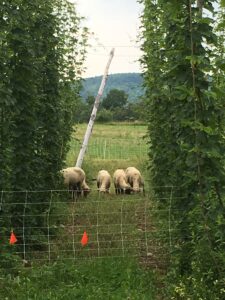
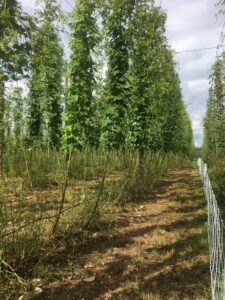
Figure 1: (Left) Sheep grazing on grasses, clover, and annuals between hops rows, after eating all of the hops leaves that could reach within a couple of days. (Right) After a week or more, almost no vegetation is left within reach of the sheep.
Downy mildew detection by qPCR
While downy mildew was detected in early season scouting on some of our varieties not included in this study (e.g. Nugget), downy mildew was uncommon to absent based on visual scouting on Cascade and Mount Hood in this experiment throughout the season. For Cascade, there were 1 basal spike each on 2 of 10 plants scouted on May 26, 2017 and zero basal spikes on 10 Mount Hood plants. On June 14, there was one spike on 1 of 10 Cascade plants and zero on Mount Hood. No DM was detected by visually scouting on the 5 replicates for any of the experimental treatments collected on 8 July or 26 August.
Downy mildew was present in the majority of samples as indicated by qPCR, although generally at relatively small concentrations. For each sampling date by variety the (%) of samples (n=40) positive for P. humuli was for Cascade: 25 May (60%), 8 July (100%), and 26 August (97.5%); and for Mount Hood: 25 May (71.25%), 8 July (100%), and 26 August (91.25%).
Based on qPCR analyses for Cascade (Figure 2, left), treatment (p=0.007) affected DM concentrations whereas crowning did not (p=0.91). By posthoc comparison of means (Tukey's HSD), sheep resulted in higher DM (0.25 pg) compared to control (0.15 pg) and Fungicide only (0.12 pg); no other pairwise comparisons were statistically different. For Mount Hood (Figure 2, right), both treatment (p=0.019) and crowning (p=0.0045) significantly affected DM, with Fungicide only having higher DM (0.12 pg) than sheep (0.047 pg), and crowning having higher DM (0.11 pg) compared to non-crowned (0.061); there were no other significant pairwise differences. Overall, there was roughly double the amount of DM in Cascade than in Mt. Hood (0.23 pg vs. 0.11 pg, p<0.001).
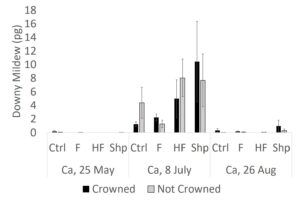
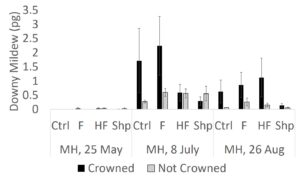
Figure 2: Average concentration in picograms (pg) of downy mildew (H. lumuli) measured by qPCR by date, variety (Ca: Cascade, MH: Mt. Hood), crowned or not, and treatment (Control, Fungicide only, Herbicide + Fungicide, Sheep), with SE bars.
Based on qPCR analyses for DM in soil, concentrations were generally much lower than on leaves (compare Figure 2 to Figure 3). For Cascade there was no effect of treatment (p=0.6) or crowning (p=0.7), whereas for Mount Hood there was not an effect of crowning (p=0.21), but, there was an effect of treatment (p=0.009). According to Tukey's test, only the crowned/fungicide only treatment was significantly different and greater than control (not crowned) and sheep (crowned or not crowned).
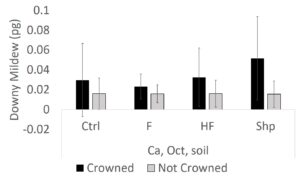
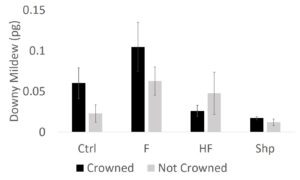
Figure 3: Average concentration in picograms (pg) of downy mildew (H. lumuli) measured by qPCR by variety (Cascade - left; Mount Hood - right), crowned or not, and treatment (Control, Fungicide only, Herbicide + Fungicide, Sheep), with SE bars.
Overall, the patterns revealed by qPCR of DM levels support some of our hypotheses but also contradict our predictions and prior work; some of these inconsistencies may be attributable to the general low incidence of DM during this growing season. For example, we either found that crowning had no effect on DM or, as with Mount Hood, resulted in higher DM. This is contradictory to other studies (Gent et al., 2012), and is inconsistent with the prediction that crowning should eliminate spores from prior years that have settled on plant tissue at or just below the soil surface. Even if crowning was not as effective, it should remove more DM spores than not crowning. Alternately, if there was little DM present in the soil (as our study shows), it may be due to factors mainly occurring within the growing season on that year's growth, and/or perhaps due to negative impacts on other beneficial microbes that may have been eliminated by crowning.
The amount of DM by treatment supported our hypothesis that sheep may reduce DM in Mount Hood, but the opposite was found in Cascade. It is difficult to explain the pattern in Cascade where the sheep treatment had more DM than the control, and the control was not different from either fungicide only or herbicide + fungicide. The best explanation is that these may be spurious results based on the generally low incidence of DM. The fact that an opposite pattern was found in Mount Hood, with fungicide only having the highest DM incidence and significantly greater than sheep, supports our hypothesis about the potential benefit of sheep to control DM.
Yield
The fresh cone weight of Cascade in the crowned plot (Figure 4, left) was highest in sheep and significantly different from either control or fungicide only. There were no treatment effects in the uncrowned plot. This difference was consistent with our hypothesis of an overall generally positive effect of sheep on hop plant growth and yield. In fact, not only were these patterns statistically significant, but, they are significant in terms of yield and positive economic impact. The average fresh cone mass for sheep-grazed Cascade hops (1.78 lbs. per bine) was 1.81 times the average weight of Cascade hops that received fungicide only (0.98 lbs. per bine). This result may indicate disruptive effects of fungicide on overall plant health, where fungicide may have a negative impact on other beneficial microbes, beneficial arthropods, or overall plant health (Calderwood et al., 2015). However, only two applications of fungicide were applied during this experiment. Bine mass was measured in senesced Mount Hood plants following harvest, as they had been completely killed by aphid and two-spotted spider mites. While there appear to be differences by treatment (Figure 4, right), these differences were not significantly different. Further, given that these were masses of mainly the stem since most leaves had dessicated or fallen off, these data are not overly informative.
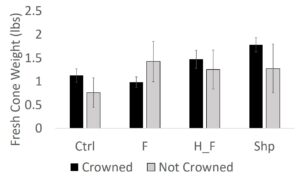
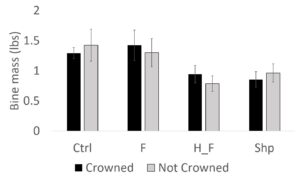
Figure 4: Mass +/- SE of harvested cones from one string with bines (Cascade, left) or of one string and bines (Mount Hood, right) post-harvest (Mount Hood plants were destroyed by aphids and two-spotted spider mites at or just prior to harvest).
Economic impacts and considerations
The costs of additional equipment, inputs, and labor per acre are summarized in Table 1, based on the the practices used in this study. Fungicide expenses are moderate ($277), with the biofungicide being more expensive than copper hydroxide (Champ), and this assumes the farm already owns a sprayer. Herbicide inputs are very expensive ($849/acre), and since the herbicide is only moderately effective and did not demonstrate any additive positive effect (in the Herbicide+Fungicide treatment), this is not considered to be a good option. However, it should be noted that we used a backpack sprayer to deliver herbicide; this labor cost could be much reduced (at least 80%) with a tractor-mounted sprayer set up to spray only the basal foliage. The cost of managing sheep ($541) was intermediate between the treatments; it would be possible to reduce this cost over the long-term if some permanent fencing were maintained with supplemental use of netting to manage different zones. Further, if a diversified farm incorporated livestock production into its business plan, these costs could be greatly minimized. While crowning bears some cost per acre ($117/acre), and we did not find much evidence of positive effects in this study, we will continue to use this practice because of other studies (Gent et al., 2012) and the fact that we observed much lower variation and possibly higher yield in crowned Cascade hops.
Table 1: The input and labor costs per acre based on experimental effort and costs. Sheep fencing supplies were amortized over a 5-year expected life. While there were only two applications of fungicide during this season, we used 4 applications as a more typical amount for budget estimation.
| unit | # | cost | units/acre | $/unit | $/acre | applications | labor hours | labor rate | $/acre | Tot/acre | Annual | ||
| Champ WG fungicide | 20 lb. | 1 | $185.00 | $185.00 | 0.984375 | $9.25 | $9.11 | 4 | 1 | $12.00 | $12.00 | $21.11 | $84.42 |
| Regalia biofungicide | 1 gallon | 3 | $96.50 | $289.50 | 0.5 | $96.50 | $48.25 | 4 | 0 | $12.00 | $0.00 | $48.25 | $193.00 |
| Avenger herbicide | 1 gallon | 5 | $53.00 | $265.00 | 4.33 | $53.00 | $229.49 | 2 | 16.25 | $12.00 | $195.00 | $424.49 | $848.98 |
| 1200' ElectroNet 9/35/12 with driveable posts | 100' roll | 7 | $134.00 | $938.00 | $187.60 | 1 | 26.75 | $12.00 | $321.00 | $508.60 | $508.60 | ||
| 35" Fiber Tuff corner support posts | each | 8 | $5.15 | $41.20 | $8.24 | 1 | $8.24 | $8.24 | |||||
| AC/DC IntelliShock10 energizer | each | 1 | $120.00 | $120.00 | $24.00 | 1 | $24.00 | $24.00 | |||||
| crowning | 1 | 9.75 | $12.00 | $117.00 | $117.00 | $117.00 |
Since yield and associated net revenue is the best measure for any farmer, we compared the differences in yield by treatment to assess economic impacts. Table 2 summarizes the yield, costs, and revenue based on our experimental data, expenses, and 2018 USDA NASS hops price per pound. There was a $1,345 higher revenue in sheep-grazed Cascade hops than in fungicide-only Cascade hops. This is a large revenue impact.
Table 2: Yield, costs, and revenue from Cascade hops crowned comparing fungicide only to sheep-grazed. Net $ does not include the other labor and input costs not studied here. Input costs are from Table 1, and other calculations include 0.2 lbs. dry hops from fresh cones, 900 plants per acre, $12/hour labor, and $5.46/pound for hops based on the 2018 USDA NASS survey (https://www.nass.usda.gov/).
| cone mass | dry yield/plant | yield/acre | labor costs | input costs | gross $ | net $ | |
| Ca, Crowned, Fung. Only | 0.984 | 0.3936 | 408.1632 | $129.00 | $69.36 | $2,228.57 | $2,030.22 |
| Ca, Crowned, Sheep | 1.78104 | 0.712416 | 738.775392 | $438.00 | $219.84 | $4,033.71 | $3,375.87 |
We sought to determine the potential impact of sheep, and other standard approaches for downy mildew control, to impact downy mildew concentrations on leaves and in soil during and after one growing season. We established four treatments (control, sheep, fungicide only, and fungicide + herbicide) with plots that were either crowned in spring or not crowned. Downy mildew was measured by visual examination and qPCR in a repeated measures design, and fresh hop yield was measured at harvest. We successfully executed the experiment and were able to manage the sheep to achieve the experimental goals. Some of our hypotheses were supported, while other results were equivocal or even opposite predictions. A summary of our research conclusions include:
- Overall, there was a low incidence of DM, and a higher amount in Cascade than Mount Hood.
- While DM was higher in sheep versus control or fungicide only in Cascade hops, the opposite was true for Mount Hood hops. Given that the crowned plants with sheep had the highest fresh hop yield, we conclude an overall benefit of sheep regardless of some equivocal results.
- Crowning also showed some equivocal or even contradictory patterns (i.e. higher DM in crowned versus non-crowned Mount Hood). Interestingly, crowned Cascade had much less variation in fresh hop yield than non-crowned Cascade. While our study does little to further support the positive benefit that others have found, importantly we did not find that crowning (along with the short growing season) had a negative impact on either yield or DM presence. We have always questioned whether we should even crown our hop plants in the relatively short growing season we have in northern Maine, and so the fact that yield was not impacted by crowning is important information.
- There was a $1,345/acre higher revenue in sheep-grazed, crowned Cascade hops than in fungicide-only crowned Cascade hops, suggesting that overall the effect of sheep grazing on overall plant health and yield are economically important.
References
Calderwood, L.B., Lewins, S.A., Darby, H.M. 2015. Survey of Northeastern Hop Arthropod Pests and Their Natural Enemies. Journal of Integrated Pest Management 6(1):18.
Darby, H., Post, J., Calderwood, L., Cummings, E., Lewins, S., Monahan, S., Zeigler, S. 2015. 2014 Hop Weed Management Report. University of Vermont. http://www.uvm.edu/extension/cropsoil/wp-ontent/uploads/2014-hops-weeding-trial-report.pdf
Delahunty, K.M. & Johnston, J.C. 2015. Strategies for Weed Management in Organic Hops, a Perennial Crop. Agronomy Journal. 107(2):634-640.
Gent, D.H., Nelson, M.E., Grove, G.G., Mahaffe, W.F., Turecheck, W.W., Woods, J.L. 2012. Association of Spring Pruning Practices with Severity of Powdery Mildew and Downy Mildew on Hop. Plant Disease 96:1343-1351.
http://msue.anr.msu.edu/news/can_michigan_hop_growers_run_sheep_through_their_hopyards
NOSB, 2015. National Organic Standards Board October 13, 2015 meeting transcript. https://www.ams.usda.gov/sites/default/files/media/NOSB%20Transcript %20October%202015.pdf
Sirrine, R. 2014. Can Michigan hopgrowers run sheep through their hopyards? Michigan State University Extension. 23 May 2014.
Summers, C. F., Adair, N. L., Gent, D. H., McGrath, M. T., & Smart, C. D. (2015). Pseudoperonospora cubensis and P. humuli detection using species-specific probes and high definition melt curve analysis. Canadian journal of plant pathology, 37(3):315-330.
Turner, S.F., C.A. Benedict, H. Darby, L.A. Hoagland, P. Simonson, J.R. Sirrine, and K.M. Murphy. 2011. Challenges and opportunities for organic hop production in the United States. Agronomy Journal 103:1645-1654.
Education & Outreach Activities and Participation Summary
Participation Summary:
- MOFGA Aroostook Tour (June 2017): 30+ people with diverse constituency had a tour of our farm with discussion of organic hop farming generally, and discussion of the experiment and challenges of sheep in organic farms.
- Aroostook Hops Field Day (September 2017): tour of the farm, harvesting, oasting, pelletizing, and packaging operation.
- Dr. Jason Johnston guest lectured twice at UMaine-Presque Isle about organic hop production: (1) Plant Biology course, and (2) Agribusiness Management course (part of UMaine-Presque Isle's newly established Sustainable Agriculture program).
- Aroostook Hops Field Day (September 2018): visitors from central to northern Maine attended and toured our farm.
- Bike Maine Agri-tour (Spetember 8, 2018): Visitors to Aroostook county participating in the Bike Maine weekend-long event toured our farm and learned about all aspects of organic hop production.
- Coastal Enterprises Inc. (CEI) "Taste Maine's Future" event (September 14, 2018): A tour led by Maine's grain leaders toured Aroostook County's grain and beer-ingredient producing region, and stopped at Aroostook Hops to learn about organic hop production.
- In October 2018, a newly redesigned Aroostook Hops website was launched, which includes a page called "Growing Hops In Maine", https://aroostookhops.com/growing-hops-in-maine. This has grower resources, and highlights our past and present SARE research projects with links where anyone can download the reports.
Learning Outcomes
- Livestock farmer (Bill Jordan) learned that sheep effectively consume hops and graze vegetation in a hopyard, while also being reassured that sheep can be managed by permanet electric moveable fencing.
- Hops farmers (Krista Delahunty and Jason Johnston) gained skills in how to manage and move sheep within a hopyard.
- Hops farmers gained knowledge in the effects of sheep and other treatments on downy mildew amounts and hops yield.
- Hops farmers gained awareness of the lack of other research on the topic of sheep in hopyards, even in places (e.g. New Zealand) where sheep are commonly used.
Project Outcomes
We have continued to use sheep in a similar fashion during 2018 in two sections (0.75 acres) of cascade in our 3-acre hopyard. We have done this while working with our organic certifier Maine Organic Farmers and Gardeners Association (MOFGA) to ensure continued OMRI compliance. Anecdotal observations in 2018 continue to support this study's conclusions that yield is positively affected by sheep grazing. Plant vigor, color, biomass, and yield appear to be positively affected by sheep. Also, two-spotted spider mite damage was reduced in these sheep-grazed plants.
While the project was generally a success, having a small sample size of 5 per treatment (due to costs of qPCR) may have reduced our statistical power to find differences or patterns. However, the year also had a low incidence of DM infection compared to other years. Thus, we think our methods were sufficient, but we may have found different results in a wetter year. Thus, we answered some of the questions we set out to understand (effect on yield), but we think there is more to understand about the potential impacts of sheep on DM. We are going to continue to phase in sheep with our hops as much is logistically feasible, because we are convinced of the multiple benefits of sheep grazing (weed control, stripping lower bines, potential DM control, some nutrient addition). Given that there is very little scientific literature, cooperative extension publications, white papers, or other information on the many potential effects of sheep on hops, we hope to continue systematic measurements in 2019 and beyond to explore the multiple benefits of sheep grazing. We think that hops growers throughout the northeastern U.S. and certified-organic growers would especially benefit from this knowledge.